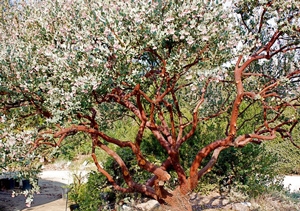Like most ornamentals grown in the garden, California native plants look better with a late winter or early spring clean-up. 
Before chopping away, the first thing you should do is ask, “why am I pruning?” Native plants are tough in some ways, but most cannot tolerate the same constant shearing or abusive amputations accepted by exotics such as Indian hawthorn or Viburnum. Pruning with prupose goes a long way toward the health of your natives.
Good reasons to prune include:
1. To remove dead or diseased growth
2. To remove crossing limbs
3. To improve air circulation and/or light penetration
4. Establish good branching structure, especially on young plants (1-3 years old)
Not-so-good reasons to prune:
1. Size control due to inappropriately placed plants (Choose the right plant for the right place whenever possible)
2. Topiary is resented by most natives. Leave this to boxwood and Dr. Seuss books.
For winter deciduous plants, dormancy provides an easy view of the branching structure so you can visualize what shape you want the plant to take and any dead branches to be removed. Avoid pruning during rainy periods to reduce infection. Native plants for dormant pruning include:
California buckeye (Aesculus californica)
Currant (Ribes spp)
Honeysuckle (Lonicera spp)
Mock orange (Philadelphus lewisii)
Pipestem clematis (Clematis lasiantha)
Spice bush (Calycanthus occidentalis)
Wild grape (Vitis californica)
Evergreen trees and shrubs generally like to be pruned soon after they have finished flowering. However, if you want the valuable seeds and berries your native garden produces, then do not prune every year, or prune lightly to retain wildlife value. Evergreens to prune in spring (after flowering) include:
California lilac (Ceanothus spp)
Coffeeberry (Frangula spp)
Manzanita\PArctostaphylos spp)
Mountain mahogany (Cercocarpus spp)
Perennials such as California fuchsia, Matilija poppy, and Lilac verbena can be coppiced to the ground now if you didn't get to it in fall. Any leftover flower stalks on Penstemon, Red-flowering buckwheat, or Sulfur buckwheat should be deadheaded.
Rejuvenation of large shrubs that have become scraggly or sparse can be done now. Rejuvenation, which involves coppicing a plant down to the ground, should only be done every 10-20 years; it mimics the loss of above-ground growth due to wildfire or other natural disasters. Plants to rejuvenate in spring include:
Blue elderberry (Sambucus cerulea)
Bush anemone (Carpenteria californica)
Coffeeberry (Frangula spp)
Coyote brush (Baccharis spp)
Honeysuckle (Lonicera spp)
Snowberry (Symphoricarpos spp)
For more details on when and how to prune California natives plants, check out the resources below:
Basics of pruning natives:
<www.cnps.org/cnps/grownative/tips/pruning01.php>
Pruning calendar and techniques:
<www.yerbabuenanursery.com/Pruning_Calendar.php>
Care and Maintenance of Southern California Gardens (book)
By Bart O'Brien, Betsey Landis, and Ellen Mackey
If you have a gardening related question you can contact the UC Master Gardeners at 209-953-6112. More information can be found on our website.